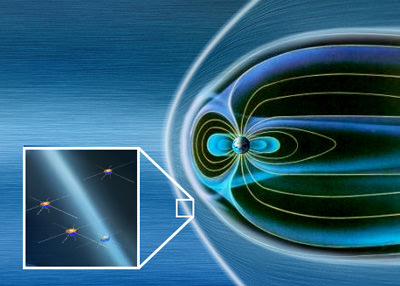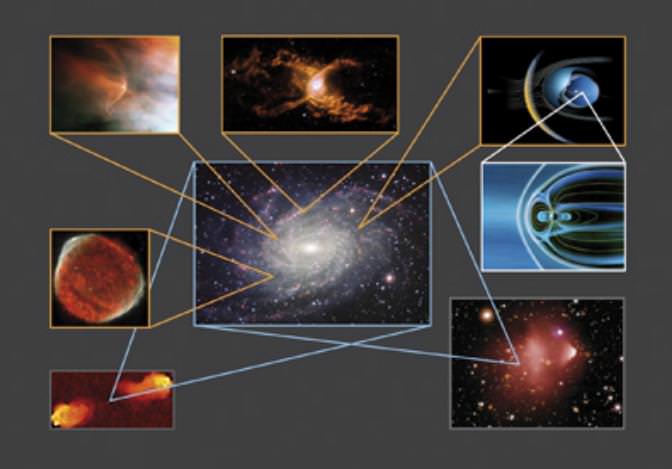[/caption]
Are you ready to dance with a new discovery? ESA’s Cluster satellites are playing the tune of cosmic particle acceleration – and it’s more efficient than speculated. Now we’re taking a look at the beginnings of universal motion. By embracing a wide variety of astronomical targetry, the images are revealing shock waves where supersonic flows of plasma encounter everything from a slow flow to an irresistible force.
What sets things in motion? When it comes to particle accelerators, something needs to set it off. Here on Earth, the Large Hadron Collider (LHC) located at Cern uses a bank of smaller machines for giving rise to the charged particles before introducing them into the mainstream. In space, cosmic rays act as this “mainstream”, but they aren’t very efficient at setting the particles going initially. Now the ESA Cluster mission has revealed what could be ” natural particle accelerators of space”.
While cruising through a magnetic shock wave, the four Cluster satellites found themselves perfectly lined up with the magnetic field. This perfect chance alignment was a revelation – allowing the mission to sample the event with incredible accuracy on a very short timescale – one of 250 milliseconds or less. What surfaced from the investigation was the realization that the electrons heated rapidly, a state which contributes to acceleration on a greater scale. While this type of action had been speculated before, it hadn’t been observed or proved. No one really knew about the process or the size of the shock layers. With this new data, Steven J. Schwartz of the Imperial College London, and his colleagues were able to estimate the thickness of the shock layer – a significant advancement in understanding, because a thinner layer means faster acceleration.
“With these observations, we found that the shock layer is about as thin as it can possibly be,” says Professor Schwartz.
So just how skinny is this dance partner? Scientists had originally estimated the shock layers above Earth to be no more than 100 km, but the satellite information showed them to be about 17 km… a very fine detail!

This type of knowledge is significant simply because shocks exists universally – originating virtually everywhere a flow encounters an obstacle or another flow. For example, here in the Solar System the Sun generates a speedy, electrically charged stellar wind. When it runs headlong into a magnetic field – such as generated by Earth – it creates a shock wave located in front of the planet. Through the Cluster mission studies, we can apply what we learn here at home and extrapolate it on a grander scale – such as those created by supernovae events, black holes and galaxies. It might even reveal the origin of cosmic rays!
“This new result reveals the size of the proverbial ‘black box’, constraining the possible mechanisms within it involved in accelerating particles,” says Matt Taylor, ESA Cluster project scientist. “Yet again, Cluster has provided us with a clear insight into a physical process that occurs throughout the Universe.”
Come on, baby. Let’s dance…
Original Story Source: ESA News Release.


Yo Tammy, referring to the sixth paragraph, in the third line: “[…], electronically charged stellar wind.”
Er… “electronically”? Would that be vacuum tubes, transistors, or microprocessors? 😉
I think that you had meant to write electrically.
At least, Tammy, cant say that nobody reads her texts very very carefuly !!!
changes made. and i appreciate the above and below comments. all i can say is how many average, ordinary housewives do you know that can do what i do?
😉
I’m left confused again, Tammy. AFAIK, particle accelerators are not really akin to bow shocks. Bow shocks may heat and change direction of a charged particle but are you comparing this action to black hole polar jets and the like? THOSE are space’s particle accelerators. Your first paragraph alludes to too much…it becomes messy and diffuse. Astronomical targetry??? Universal Motion??? Apply the KISS principal to your writing and we’ll follow happily.
I can see how it is confusing. Each to her own style. Plotner is successful, mind.
But after that you seem to be not KISSing in your analysis. The claim was, as I read it, more knowledge on specific but germane magnetic field behavior would ease understanding of them in general.
Because articles, and authors, need HUGS too. (HUGS: Hugely Urgent Grip on Subject, aka embracing the stuff for what it is.)
Careful, I criticised Tammy once (and only once) and was permanently banned from using that email/identity. Haven’t participated at UT since.
I love Cluster! (Disclaimer: I am partial, having learned about the science use at IRF in Uppsala.)
But what really caught my attention was the artist’s new image of the Solar System geometry. For once they have adopted the new more or less ellipsoid observed configuration of the heliosphere. But I dunno about the shock and the assumed asymmetry of the transition regions. We need observations.
UPDATE: Nope, I misunderstood, see the comparison figs at “Cassini results”. The ellipsoid is the heliosheat, and the figure depicts the old model still.
And the bow shock seems observed elsewhere, I forgot that.